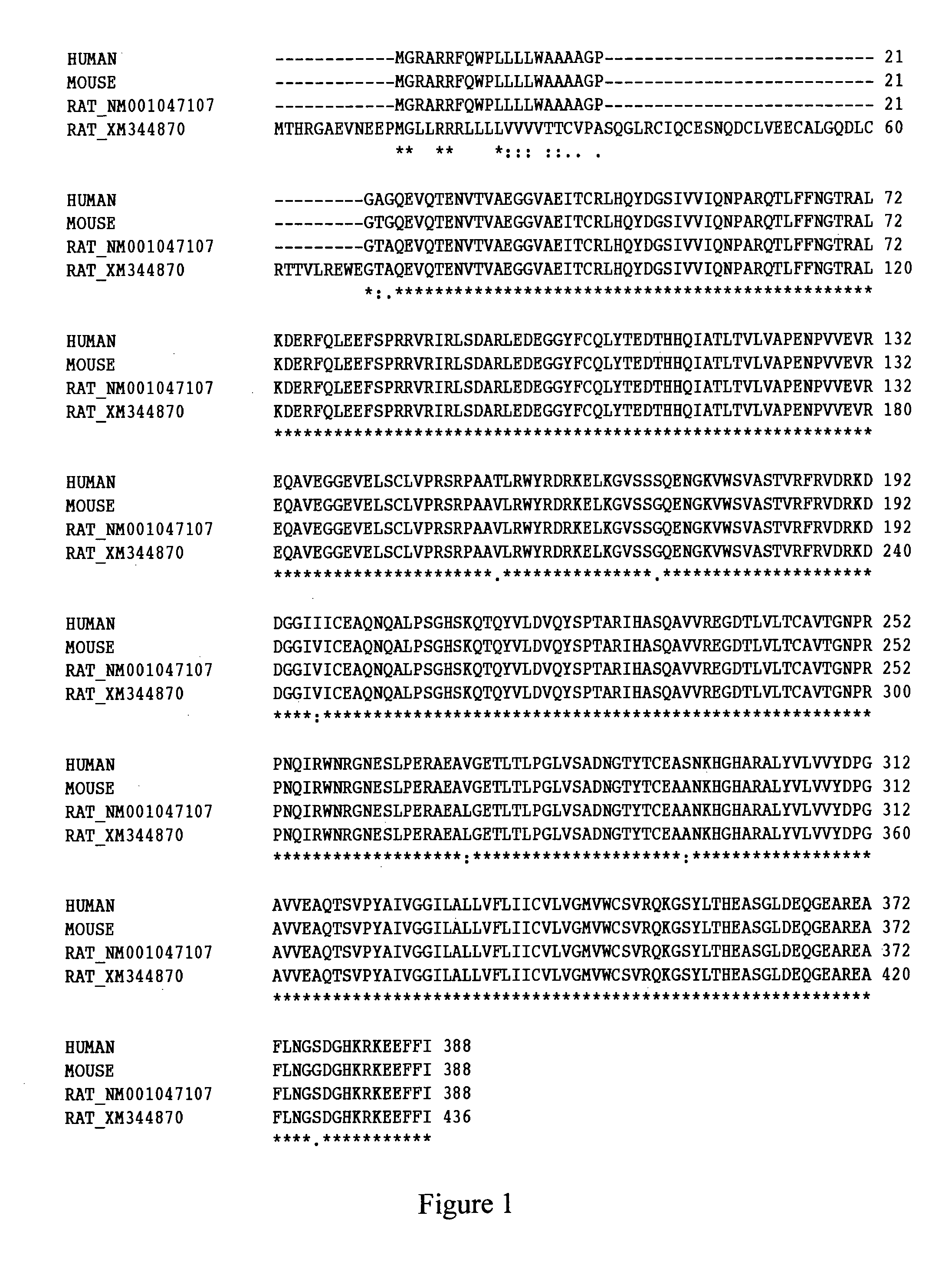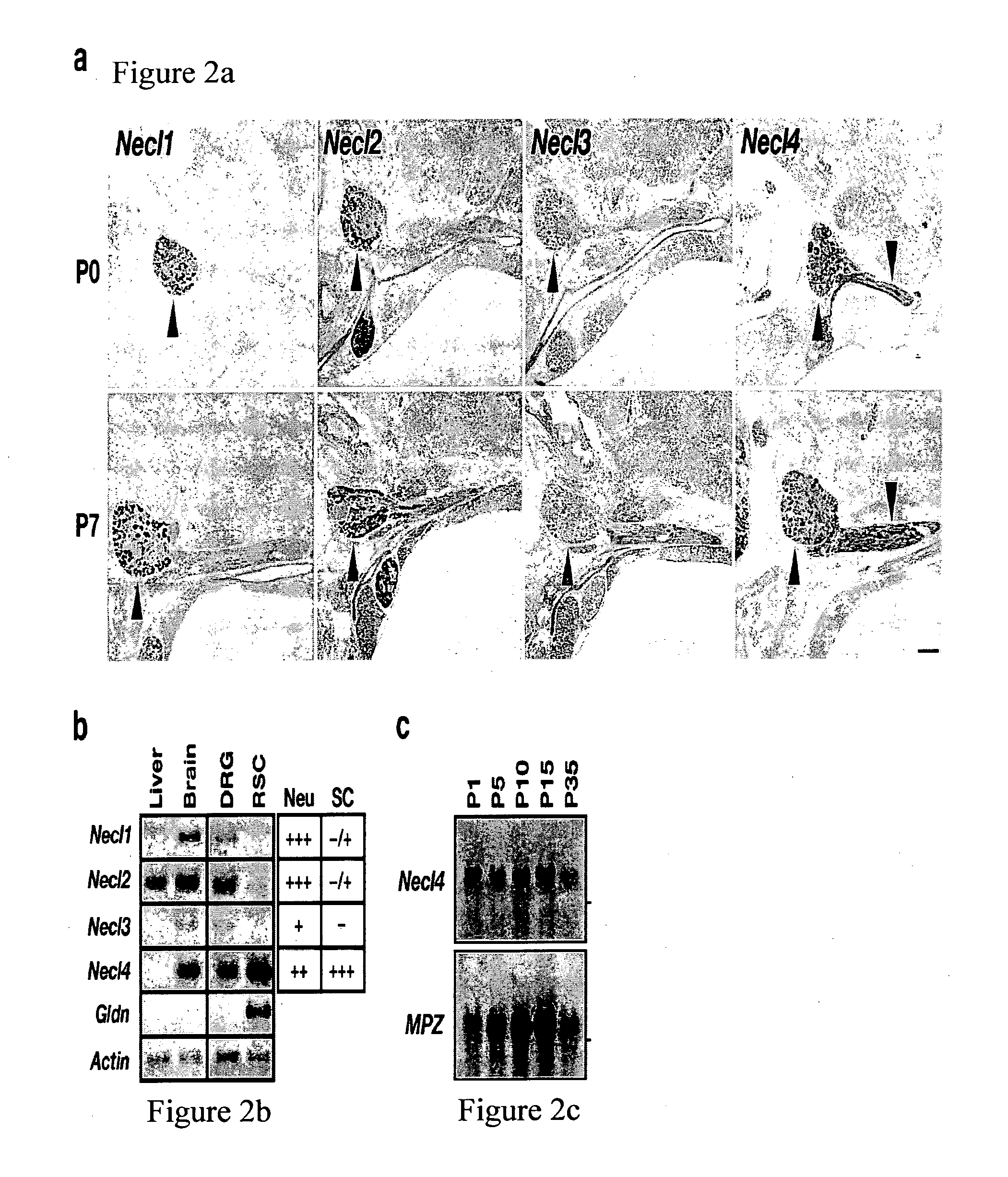Regulation of myelination by nectin-like (NECL) molecules
a technology of nectin-like molecules and myelination, which is applied in the field of nectin-like molecules that regulate myelination, can solve the problems of pns or cns demyelination, the identification of cell adhesion and recognition molecules (cams) that mediate axon-schwann cell interaction during myelination has remained elusive, and the information regarding the function of necls in the nervous system
- Summary
- Abstract
- Description
- Claims
- Application Information
AI Technical Summary
Benefits of technology
Problems solved by technology
Method used
Image
Examples
example 1
Isolation of Necl Molecules Using a Signal Sequence Trap
[0237]In order to isolate cell surface molecules that mediate axon-glial interactions at the onset of myelination and during maintenance of the myelin sheath, a signal sequence trap technique was used to screen a Schwann cell library and a sciatic nerve cell library, as previously described (Spiegel et al. 2006). The rationale of the technique is that signal sequences, which direct cell surface proteins to the cell surface, can be detected in cDNA fragments, based on the ability to redirect a constitutively active mutant of the thrombopoeitin receptor MPL (MPLM) to the cell surface, thereby permitting IL-3-independent growth of Ba / F3 cells, which, otherwise, require IL-3 for survival (Kojima and Kitamura, 1999). The retroviral REX-SST contains a truncated MPLM variant that lacks most of the extracellular domain, including the signal sequence. Cloning a cDNA that contains a signal sequence in frame to the MPLM sequence will dire...
example 2
Members of the Necl Family are Found in the Peripheral Nervous System
[0241]To examine the expression of Necls in the PNS, we performed in situ hybridization of newborn and 7-day old rats using specific probes for Necl1, Necl2, Necl3 and Necl4 (FIG. 2a). Necl1, Necl2 and Necl4 were clearly detected in dorsal root ganglia. In contrast to the other Necl2, Necl4 was also detected in Schwann cells located along the nerve. The expression of Necl4 dramatically increases in myelinating Schwann cells during the first postnatal week, which corresponds to the initial period of active myelination in the PNS.
[0242]RT-PCR analysis on mRNA isolated from cultured dorsal root ganglia (DRG) neurons and Schwann cells showed that while transcripts of all four Necls could be detected in DRG neurons, cultured Schwann cells express high levels of Necl4 and low levels of Necl2, but do not express Necl1 or Necl3 (FIG. 2b).
[0243]Northern blot analysis of sciatic nerve from different postnatal days demonstrat...
example 3
The Expression of Necl4 in Schwann Cells is Induced by Axonal Contact and Myelination
[0246]To determine the expression of Ned proteins in peripheral nerve, antibodies were raised to Necl1 and Necl4. The specificity of these antibodies was examined using COS-7 cells expressing the different Necl proteins (FIG. 4A). Anti-Necl4 was found to be specific to this Necl and did not recognize Necl1-Necl3, while the anti-Necl1 antibody reacted with Necl1, weakly with Necl2, but not with Necl3 or Necl4. Immunolabeling of cultured rat Schwann cells with these antibodies showed an intense immunoreactivity of Necl4, but not of Necl1 at the cell membrane and processes (FIG. 3). Staining of isolated DRG neurons revealed high levels of Necl1 and weaker levels of Necl4 in the cell soma and along the axons (identified by βIII-tubulin; lower panels in FIG. 3).
[0247]While both Necl4 and Necl1 could be immunoprecipitated from rat brain, only Necl4, but not Necl1 was detected in cultured rat Schwann cells...
PUM
| Property | Measurement | Unit |
|---|---|---|
| pH | aaaaa | aaaaa |
| pH | aaaaa | aaaaa |
| temperature | aaaaa | aaaaa |
Abstract
Description
Claims
Application Information
 Login to View More
Login to View More - R&D
- Intellectual Property
- Life Sciences
- Materials
- Tech Scout
- Unparalleled Data Quality
- Higher Quality Content
- 60% Fewer Hallucinations
Browse by: Latest US Patents, China's latest patents, Technical Efficacy Thesaurus, Application Domain, Technology Topic, Popular Technical Reports.
© 2025 PatSnap. All rights reserved.Legal|Privacy policy|Modern Slavery Act Transparency Statement|Sitemap|About US| Contact US: help@patsnap.com



